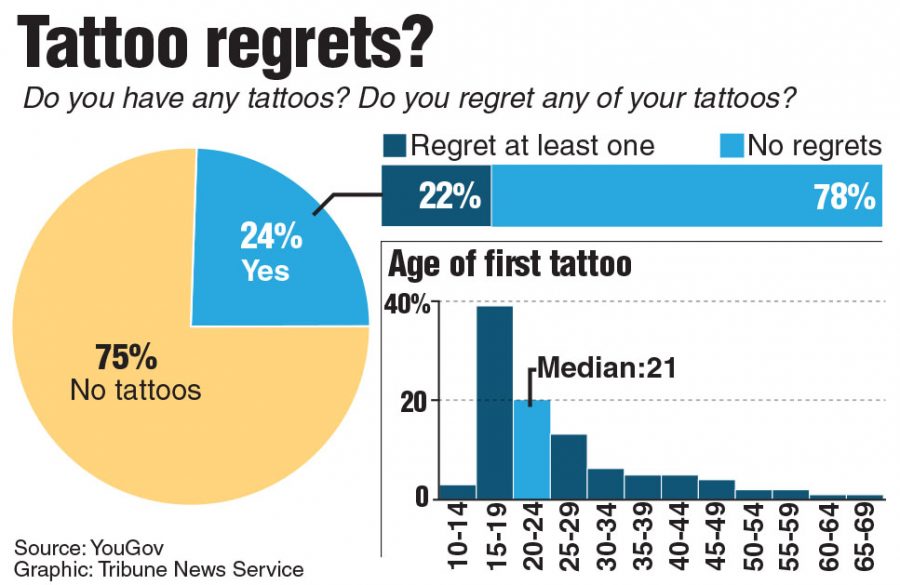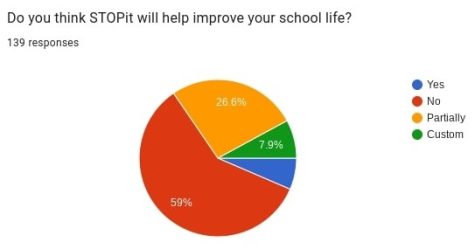High School Tattoo Statistics
Survey results on tattoo regrets along with a chart showing the median age for a first tattoo. Tribune News Service
Tattoos have gone in and out of popularity for years. Recently, however, there has been an increase in tattoos with younger people. With more tolerance for displays of creativity on one’s body, tattoos have continued to become one of the most common ways to express interests and opinions in a physical and permanent way.
Tattoos are a “form of body modification, which are any changes made to the body for spiritual, fashion, social, or personal reasons,” according to A Cultural History of Body Piercing by Bonnie Szumski and Jill Karson.
Tattoos have been around since the Early Dynastic Period and it is believed they were used by the Egyptians.
According to the website AuthorityTattoo, tattoos date back to 3370 BC and 3100 BC and there’s evidence that tattooing was an ancient art form.
The History of Tattoos website states that people in ancient Egypt and India used tattoos to express themselves religiously and even to heal themselves. They also report that tattoos became more popular during the hippie era as a form of expressing one’s identity.
Moreover, History of Tattoos stated that the “oldest surviving tattoos are the ones found on Ötzi the Iceman, a mummy found in the Ötz valley in the Alps and dating from the 5th to 4th millennium BC.”
Today, tattoos are seen more in the younger generation. According to the article “Are People With Tattoos Stigmatized?” by Vinita Mehta in Psychology Today, “47 percent of millennials have tattoos, in comparison to 36 percent of Generation Xers, and 13 percent of baby boomers.”
Mehta also speculates that people with tattoos are seen as social outcasts and are perceived as having a bad attitude.
Despite that, A Cultural History of Body Piercing stated that a small number of studies on teens with tattoos has linked tattoos with low self-esteem.
Although tattoos may be a preferred way to express oneself, tattoos can also be quite risky. Because the skin is broken, there is a chance to contract many blood-borne diseases. Most tattoo parlors are required to use one-use needles, but the risk still stands. Tattoos could also lead to bacterial infections or allergic reactions, but if treated properly should not be a problem.
According to Healthline.com, the reason tattoos could pose health problems is because, “When you receive a tattoo, a tattoo artist uses a handheld machine with an attached needle to puncture the skin. Every time this device makes a hole, it injects ink into the dermis — the second layer of skin below the epidermis,” which can then expose the skin to bacteria from the needle.
Even if tattoos have downsides, they can also be beneficial.
Tattoos can reduce stress, according to Chronic Ink. They explained that a person with multiple tattoos has lower cortisol levels, which is a stress hormone.
This happens because, “The body produces cortisol in an attempt to reduce pain… Multiple tattoos result in the cortisol hormone response to be less active. That means less cortisol is produced, resulting in stress reduction.”
Tattoos are always a good way to show one’s individualism, and despite people regretting tattoos, most people don’t because they tell a story.
Amelia Abraham wrote in her article How I Feel About My Tattoos, Years Later, “every tattoo has a story — of irresponsibility, friendship, a trip abroad. A story of letting a friend practice their tattooing skills, or letting a tattoo artist demonstrate their lack thereof. Tattoos tell us something about a person, whether that person intends them to or not.”






